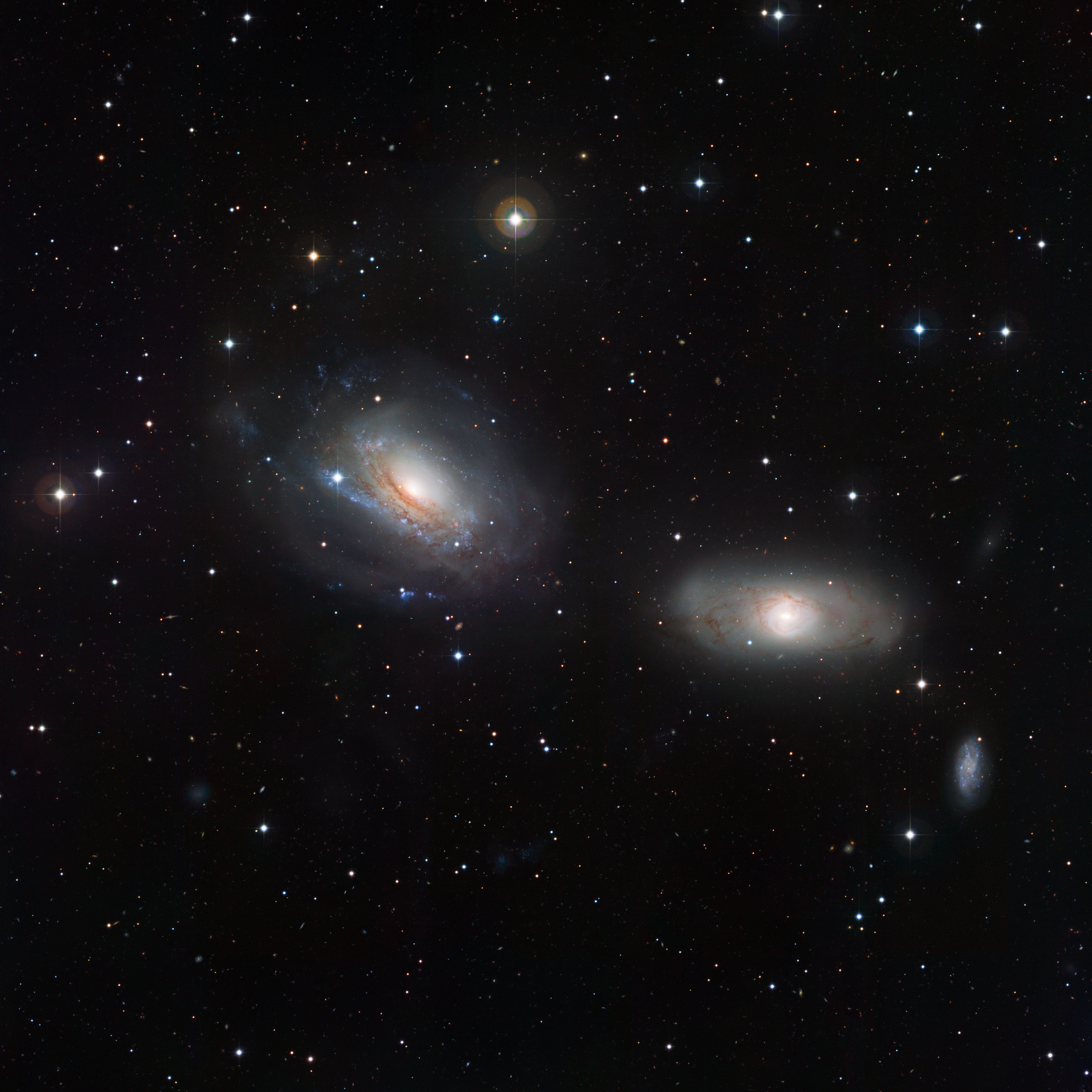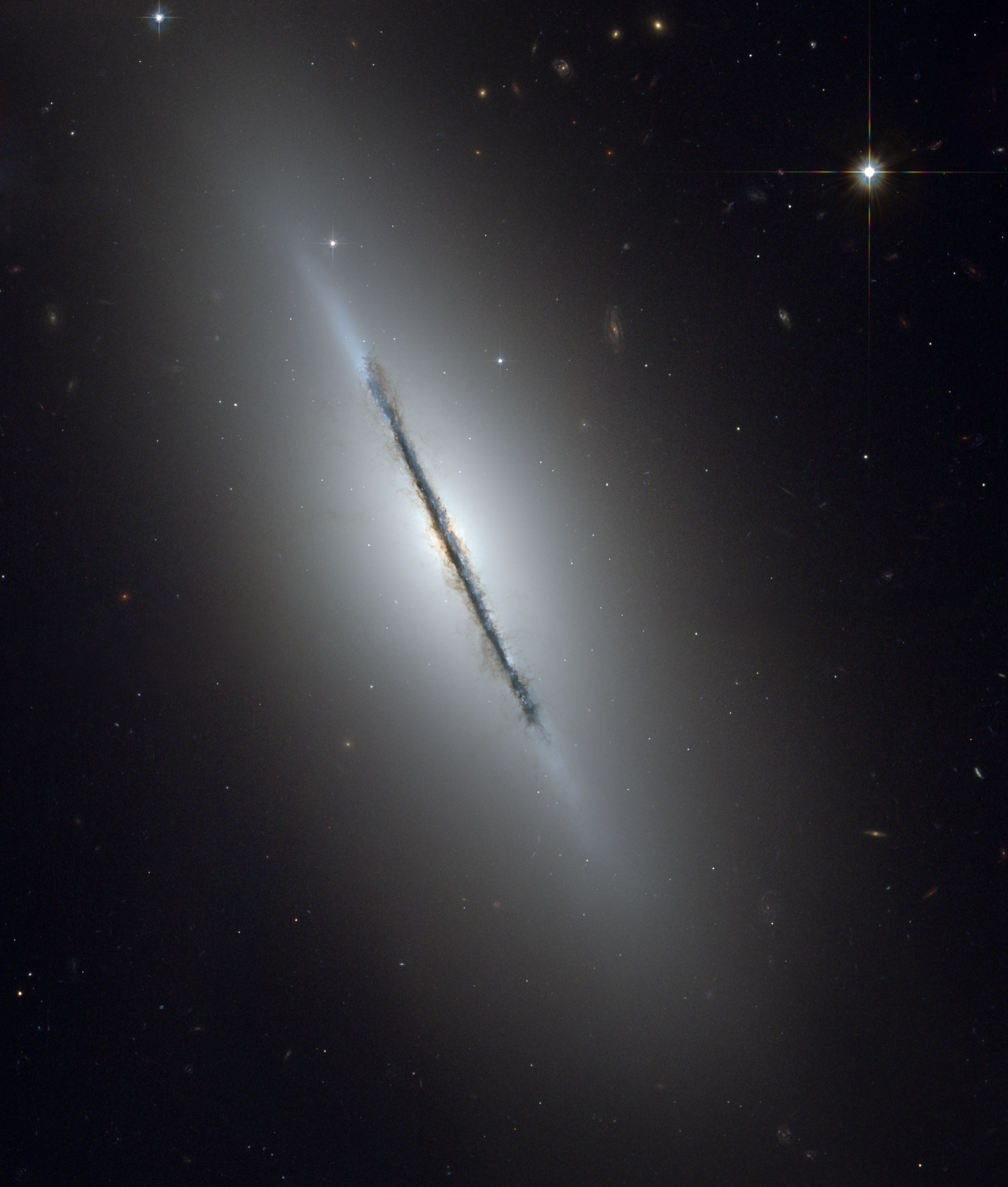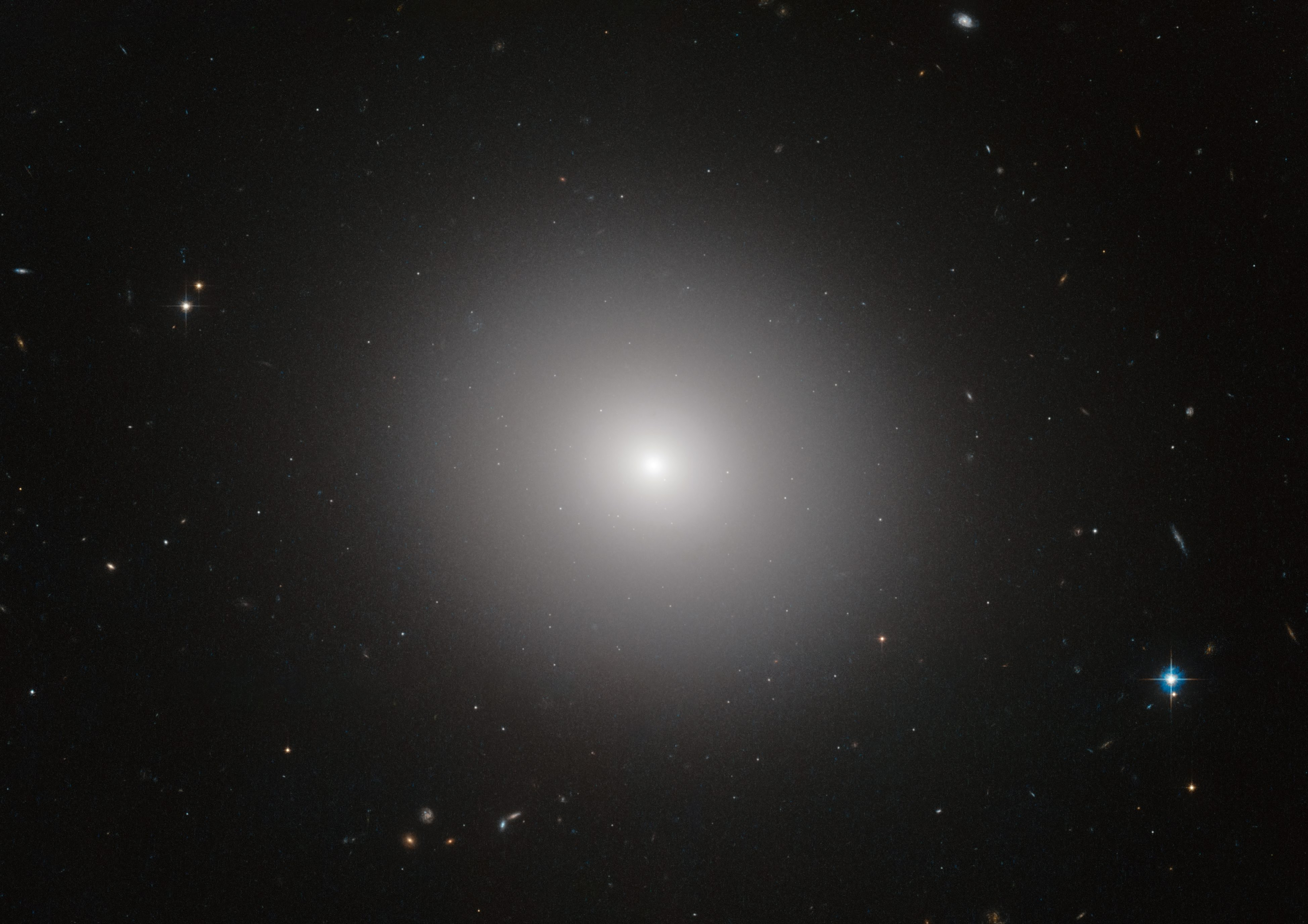|
LEDA 2108986
LEDA 2108986, also known by its Case Western Reserve University designation "Case Galaxy 611" (CG 611), is an extremely isolated, early-type dwarf galaxy with an embedded spiral structure residing in what is likely an intermediate-scale disk. The galaxy was discovered in 1987 by Sanduleak and Pesch, and is located at a distance of about in the Boötes Void and has no significant neighbours within 2.5 Mpc. The galaxy may be a counterpart to the rectangular-shaped galaxy LEDA 74886, in that they both appear to contain an intermediate-scale disk. In the case of LEDA 74886, that disk is orientated edge-on to our line-of-sight. The "early-type galaxy" class is commonly known to contain elliptical galaxies (E) with no substantial stellar disk (perhaps just a small nuclear disk) and lenticular galaxies (S0) with their large-scale disks that dominate the light at large radii. Bridging these two types of galaxies are the ES galaxies with their intermediate-scale disks, referred ... [...More Info...] [...Related Items...] OR: [Wikipedia] [Google] [Baidu] |
Canada–France–Hawaii Telescope
The Canada–France–Hawaii Telescope (CFHT) is located near the summit of Mauna Kea mountain on Hawaii's Big Island at an altitude of 4,204 meters (13,793 feet), part of the Mauna Kea Observatory. Operational since 1979, the telescope is a Prime Focus/Cassegrain configuration with a usable aperture diameter of . CFHT currently planning a refurbishment to the facility in the 2020s. The facility will be reconstructed with a new 11-m telescope to produce the Maunakea Spectroscopic Explorer, retaining the same base building and infrastructure. First light is expected in 2029. Funding The corporation is bound by a tripartite agreement between the University of Hawaii at Manoa, in the United States, the National Research Council (NRC) in Canada and the Centre National de la Recherche Scientifique (CNRS) in France. CFHT also has partnerships with the National Astronomical Observatory of China (NAOC), the Academia Sinica Institute of Astronomy and Astrophysics (ASIAA) in Taiwan, the ... [...More Info...] [...Related Items...] OR: [Wikipedia] [Google] [Baidu] |
Dwarf Elliptical Galaxy
Dwarf elliptical galaxies, or dEs, are elliptical galaxies that are smaller than ordinary elliptical galaxies. They are quite common in galaxy groups and clusters, and are usually companions to other galaxies. Examples "Dwarf elliptical" galaxies should not be confused with the rare "compact elliptical" galaxy class, of which M32, a satellite of the Andromeda Galaxy, is the prototype. In 1944 Walter Baade confirmed dwarf ellipticals NGC 147 and NGC 185 as members of the Local Group by resolving them into individual stars, thanks to their relatively little distance. In the 1950s, dEs were also discovered in the nearby Fornax and Virgo clusters. Relation to other elliptical galaxy types Dwarf elliptical galaxies have blue absolute magnitudes within the range fainter than ordinary elliptical galaxies. The surface brightness profiles of ordinary elliptical galaxies was formerly approximated using ''de Vaucouleur's model'', while dEs were approximated with an exponential ... [...More Info...] [...Related Items...] OR: [Wikipedia] [Google] [Baidu] |
LEDA Objects
Leda may refer to: Mythology * Leda (mythology), queen of Sparta and mother of Helen of Troy in Greek mythology Places * Leda, Western Australia, a suburb of Perth, Western Australia * Leda makeshift settlement, Bangladesh, a refugee camp for Rohingya refugees fleeing persecution in Myanmar * Leda, Burkina Faso, a town * Leda, Adamawa State, Nigeria, a village - see List of villages in Adamawa State * Leda (river), a tributary of the Ems in Germany * Leda Ridge, Antarctica Astronomy * Leda (moon), a moon of Jupiter * 38 Leda, an asteroid * Leda, the original proposed name for exoplanet Thestias * Lyon-Meudon Extragalactic Database, an astronomical catalog of galaxies * Large Aperture Experiment to Detect the Dark Ages, a radio interferometer Entertainment * '' Leda: The Fantastic Adventure of Yohko'', a 1985 Japanese OVA * ''Web of Passion'', a French film released in the US as ''Leda'' * Project Leda, a set of female clones in the TV series ''Orphan Black'' Ships ... [...More Info...] [...Related Items...] OR: [Wikipedia] [Google] [Baidu] |
NGC 4291
NGC commonly refers to: * New General Catalogue of Nebulae and Clusters of Stars, a catalogue of deep sky objects in astronomy NGC may also refer to: Companies * NGC Corporation, name of US electric company Dynegy, Inc. from 1995 to 1998 * National Gas Company of Trinidad and Tobago, state-owned natural gas company in Trinidad and Tobago * National Grid plc, a former name of National Grid Electricity Transmission plc, the operator of the British electricity transmission system * Northrop Grumman Corporation, aerospace and defense conglomerate formed from the merger of Northrop Corporation and Grumman Corporation in 1994 * Numismatic Guaranty Corporation, coin certification company in the United States Other uses * National Gallery of Canada, art gallery founded in 1880 in Ottawa, Canada * National Geographic, documentary and reality television channel established in the United States in 2001 formerly called National Geographic Channel * Native Girls Code, US non-profit organ ... [...More Info...] [...Related Items...] OR: [Wikipedia] [Google] [Baidu] |
NGC 1332
NGC 1332 is an almost edge-on elliptical galaxy located in constellation of Eridanus. Situated about 70 million light years away, it is a member of the Eridanus cluster of galaxies, a cluster of about 200 galaxies. It is also the brightest member of the NGC 1332 Group. It was discovered by William Herschel on 9 December 1784. NGC 1332 has a Hubble classification of E, which indicates it is an elliptical galaxy. It is moving away from the Milky Way at a rate of 1,553 km/s. Its size on the night sky is 4.5' x 1.4' which is proportional to its real size of 92 000 ly. NGC 1332 is an early-type galaxy. Despite their name, early-type galaxies are much older than spiral galaxies, and mostly comprise old, red-colored stars. Very little star formation occurs in these galaxies; the lack of star formation in elliptical galaxies appears to start at the center and then slowly propagates outward. One supernova has been observed in NGC 1332: SN 1982E (type unknown, mag. 14). Black hol ... [...More Info...] [...Related Items...] OR: [Wikipedia] [Google] [Baidu] |
NGC 1277
NGC 1277 is a lenticular galaxy in the constellation of Perseus. It is a member of the Perseus Cluster of galaxies and is located approximately 73 Mpc (megaparsecs) or 220 million light-years from the Milky Way. It has an apparent magnitude of about 14.7. It was discovered on December 4, 1875 by Lawrence Parsons, 4th Earl of Rosse. NGC 1277 has been called a " relic of the early universe" due to its stars being formed during a 100 million year interval about 12 billion years ago. Stars were formed at a rate of 1000 times that of the Milky Way galaxy's formation rate in a short burst of time. After this process of stellar formation ran its course, NGC 1277 was left populated with metal-rich stars that are about 7 billion years older than the Sun. It is still uncertain whether or not NGC 1277 is a "relic galaxy"; current studies are still researching the possibility. However, observations with Hubble Space Telescope indicate that NGC 1277 lacks metal-poor globular clusters, suggest ... [...More Info...] [...Related Items...] OR: [Wikipedia] [Google] [Baidu] |
NGC 1271
NGC 1271 is a compact elliptical or lenticular galaxy located about 250 million light-years away in the constellation Perseus. The galaxy was discovered by astronomer Guillaume Bigourdan on November 14, 1884. NGC 1271 is a member of the Perseus Cluster and has a nuclear dust disk in its center. It also has an edge-on, intermediate-scale disk and has a central bulge. Like NGC 1277, NGC 1271 is a candidate " relic galaxy". Supermassive black hole Using orbital-based stellar dynamical models, Walsh et al. determined that the supermassive black hole in the center of NGC 1271 has a mass of . See also * List of NGC objects (1001–2000) * NGC 1277 References External links {{DEFAULTSORT:NGC 1271 Perseus Cluster Perseus (constellation) Elliptical galaxies Lenticular galaxies 1271 Year 1271 (Roman numerals, MCCLXXI) was a common year starting on Thursday (link will display the full calendar) of the Julian calendar. Events By place Europe * July 2 – ... [...More Info...] [...Related Items...] OR: [Wikipedia] [Google] [Baidu] |
Interacting Galaxy
Interacting galaxies (''colliding galaxies'') are galaxies whose gravitational fields result in a disturbance of one another. An example of a minor interaction is a satellite galaxy disturbing the primary galaxy's spiral arms. An example of a major interaction is a galactic collision, which may lead to a galaxy merger. Satellite interaction A giant galaxy interacting with its satellites is common. A satellite's gravity could attract one of the primary's spiral arms. Alternatively, the secondary satellite can dive into the primary galaxy, as in the Sagittarius Dwarf Elliptical Galaxy diving into the Milky Way. That can possibly trigger a small amount of star formation. Such orphaned clusters of stars were sometimes referred to as "blue blobs" before they were recognized as stars. Galaxy collision Colliding galaxies are common during galaxy evolution. The extremely tenuous distribution of matter in galaxies means these are not collisions in the traditional sense of the wo ... [...More Info...] [...Related Items...] OR: [Wikipedia] [Google] [Baidu] |
Lenticular Galaxy
A lenticular galaxy (denoted S0) is a type of galaxy intermediate between an elliptical (denoted E) and a spiral galaxy in galaxy morphological classification schemes. It contains a large-scale disc but does not have large-scale spiral arms. Lenticular galaxies are disc galaxies that have used up or lost most of their interstellar matter and therefore have very little ongoing star formation. They may, however, retain significant dust in their disks. As a result, they consist mainly of aging stars (like elliptical galaxies). Despite the morphological differences, lenticular and elliptical galaxies share common properties like spectral features and scaling relations. Both can be considered early-type galaxies that are passively evolving, at least in the local part of the Universe. Connecting the E galaxies with the S0 galaxies are the ES galaxies with intermediate-scale discs. Morphology and structure Classification Lenticular galaxies are unique in that they have a vis ... [...More Info...] [...Related Items...] OR: [Wikipedia] [Google] [Baidu] |
J2000
In astronomy, an epoch or reference epoch is a moment in time used as a reference point for some time-varying astronomical quantity. It is useful for the celestial coordinates or orbital elements of a celestial body, as they are subject to perturbations and vary with time. These time-varying astronomical quantities might include, for example, the mean longitude or mean anomaly of a body, the node of its orbit relative to a reference plane, the direction of the apogee or aphelion of its orbit, or the size of the major axis of its orbit. The main use of astronomical quantities specified in this way is to calculate other relevant parameters of motion, in order to predict future positions and velocities. The applied tools of the disciplines of celestial mechanics or its subfield orbital mechanics (for predicting orbital paths and positions for bodies in motion under the gravitational effects of other bodies) can be used to generate an ephemeris, a table of values giving the positions ... [...More Info...] [...Related Items...] OR: [Wikipedia] [Google] [Baidu] |
Elliptical Galaxy
An elliptical galaxy is a type of galaxy with an approximately ellipsoidal shape and a smooth, nearly featureless image. They are one of the four main classes of galaxy described by Edwin Hubble in his Hubble sequence and 1936 work ''The Realm of the Nebulae'', with their intermediate scale disks, a subset of the "early-type" galaxy population. Most elliptical galaxies are composed of older, low-mass stars, with a sparse interstellar medium and minimal star formation activity, and they tend to be surrounded by large numbers of globular clusters. Elliptical galaxies are believed to make up approximately 10–15% of galaxies in the Virgo Supercluster, and they are not the dominant type of galaxy in the universe overall. They are preferentially found close to the centers of galaxy clusters. Elliptical galaxies range in size from dwarf ellipticals with tens of millions of stars, to supergiants of over one hundred trillion stars that dominate their galaxy clusters. Originall ... [...More Info...] [...Related Items...] OR: [Wikipedia] [Google] [Baidu] |




